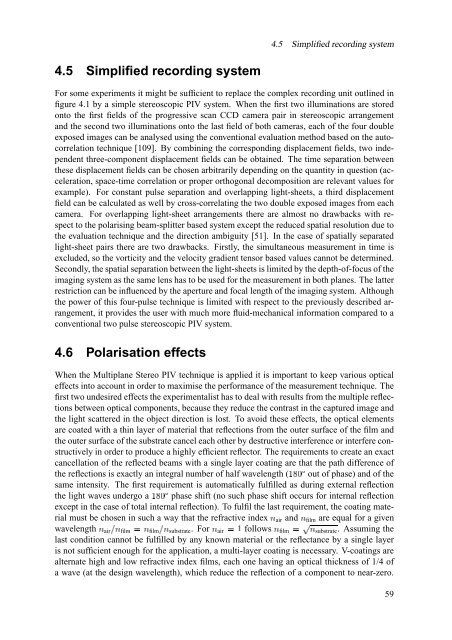The significance of coherent flow structures for the turbulent mixing ...
The significance of coherent flow structures for the turbulent mixing ...
The significance of coherent flow structures for the turbulent mixing ...
Create successful ePaper yourself
Turn your PDF publications into a flip-book with our unique Google optimized e-Paper software.
4.5 Simplified recording system<br />
4.5 Simplified recording system<br />
For some experiments it might be sufficient to replace <strong>the</strong> complex recording unit outlined in<br />
figure 4.1 by a simple stereoscopic PIV system. When <strong>the</strong> first two illuminations are stored<br />
onto <strong>the</strong> first fields <strong>of</strong> <strong>the</strong> progressive scan CCD camera pair in stereoscopic arrangement<br />
and <strong>the</strong> second two illuminations onto <strong>the</strong> last field <strong>of</strong> both cameras, each <strong>of</strong> <strong>the</strong> four double<br />
exposed images can be analysed using <strong>the</strong> conventional evaluation method based on <strong>the</strong> autocorrelation<br />
technique [109]. By combining <strong>the</strong> corresponding displacement fields, two independent<br />
three-component displacement fields can be obtained. <strong>The</strong> time separation between<br />
<strong>the</strong>se displacement fields can be chosen arbitrarily depending on <strong>the</strong> quantity in question (acceleration,<br />
space-time correlation or proper orthogonal decomposition are relevant values <strong>for</strong><br />
example). For constant pulse separation and overlapping light-sheets, a third displacement<br />
field can be calculated as well by cross-correlating <strong>the</strong> two double exposed images from each<br />
camera. For overlapping light-sheet arrangements <strong>the</strong>re are almost no drawbacks with respect<br />
to <strong>the</strong> polarising beam-splitter based system except <strong>the</strong> reduced spatial resolution due to<br />
<strong>the</strong> evaluation technique and <strong>the</strong> direction ambiguity [51]. In <strong>the</strong> case <strong>of</strong> spatially separated<br />
light-sheet pairs <strong>the</strong>re are two drawbacks. Firstly, <strong>the</strong> simultaneous measurement in time is<br />
excluded, so <strong>the</strong> vorticity and <strong>the</strong> velocity gradient tensor based values cannot be determined.<br />
Secondly, <strong>the</strong> spatial separation between <strong>the</strong> light-sheets is limited by <strong>the</strong> depth-<strong>of</strong>-focus <strong>of</strong> <strong>the</strong><br />
imaging system as <strong>the</strong> same lens has to be used <strong>for</strong> <strong>the</strong> measurement in both planes. <strong>The</strong> latter<br />
restriction can be influenced by <strong>the</strong> aperture and focal length <strong>of</strong> <strong>the</strong> imaging system. Although<br />
<strong>the</strong> power <strong>of</strong> this four-pulse technique is limited with respect to <strong>the</strong> previously described arrangement,<br />
it provides <strong>the</strong> user with much more fluid-mechanical in<strong>for</strong>mation compared to a<br />
conventional two pulse stereoscopic PIV system.<br />
4.6 Polarisation effects<br />
When <strong>the</strong> Multiplane Stereo PIV technique is applied it is important to keep various optical<br />
effects into account in order to maximise <strong>the</strong> per<strong>for</strong>mance <strong>of</strong> <strong>the</strong> measurement technique. <strong>The</strong><br />
first two undesired effects <strong>the</strong> experimentalist has to deal with results from <strong>the</strong> multiple reflections<br />
between optical components, because <strong>the</strong>y reduce <strong>the</strong> contrast in <strong>the</strong> captured image and<br />
<strong>the</strong> light scattered in <strong>the</strong> object direction is lost. To avoid <strong>the</strong>se effects, <strong>the</strong> optical elements<br />
are coated with a thin layer <strong>of</strong> material that reflections from <strong>the</strong> outer surface <strong>of</strong> <strong>the</strong> film and<br />
<strong>the</strong> outer surface <strong>of</strong> <strong>the</strong> substrate cancel each o<strong>the</strong>r by destructive interference or interfere constructively<br />
in order to produce a highly efficient reflector. <strong>The</strong> requirements to create an exact<br />
cancellation <strong>of</strong> <strong>the</strong> reflected beams with a single layer coating are that <strong>the</strong> path difference <strong>of</strong><br />
<strong>the</strong> reflections is exactly an integral number <strong>of</strong> half wavelength (<br />
÷aóaü<br />
out <strong>of</strong> phase) and <strong>of</strong> <strong>the</strong><br />
same intensity. <strong>The</strong> first requirement is automatically fulfilled as during external reflection<br />
<strong>the</strong> light waves undergo a ¤ ÷aóaü<br />
phase shift (no such phase shift occurs <strong>for</strong> internal reflection<br />
except in <strong>the</strong> case <strong>of</strong> total internal reflection). To fulfil <strong>the</strong> last requirement, <strong>the</strong> coating material<br />
must be chosen in such a way that <strong>the</strong> refractive index<br />
¤ air and Z film are equal <strong>for</strong> a given<br />
Z<br />
wavelength Z air<br />
Z film èsZ film<br />
Z substrate. For Z air è<br />
¤<br />
follows Z film è—– Z substrate. Assuming <strong>the</strong><br />
last condition cannot be fulfilled by any known material or <strong>the</strong> reflectance by a single layer<br />
is not sufficient enough <strong>for</strong> <strong>the</strong> application, a multi-layer coating is necessary. V-coatings are<br />
alternate high and low refractive index films, each one having an optical thickness <strong>of</strong> 1/4 <strong>of</strong><br />
a wave (at <strong>the</strong> design wavelength), which reduce <strong>the</strong> reflection <strong>of</strong> a component to near-zero.<br />
59
















